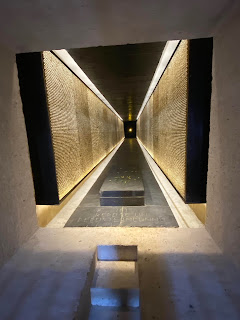At an award lunch at a history of science event in Paris, I was seated with Christian Amatore, a professor emeritus of electrochemistry at the Ecole Normal Superieure (ENS). Christian is a bright, funny and out-going man who smiles easily. He said he lived in America for two years early in his career in Bloomington, Indiana.
We talked about how much we liked visiting each other's country then turned to the differences in growing up in America and France in the middle of the last century. Christian had a straight career path that began at ten years old, when a teacher identified him as having potential for a science career.
Christian was born in Algeria in 1951 and spent his early years on French Army bases. His father emigrated from Italy after World War II, his mother from Sweden. Service in the Foreign Legion was a rapid path to citizenship for his family. Christian's father was a career sergeant who told his son to get an education and be one of the leaders, "or you will be a nobody."
In 1970, he started college at ENS, beginning his PhD program in 1974 and completing it in 1979. He was a professor after completing the PhD and three years later began two years of research and teaching at the University of Indiana.
As we talked about his linear career path I told him of the twists and turns of mine. Christian never served in the military. His father looked back on the Army as something he did to have a better life for his family. During the years Christian was completing his PhD I was 600 kilometers east of Paris in a tank on the east-west border. I started college in America in 1980 when he beginning his first professorship.
For my father, world War II was the best years of his life. He went in the Army on the eve of the war in his mid-30s with an eighth grade education. When the war began, the Army sent Dad to Officer Candidate School. He was commissioned, commanded a several small units and ended the war a captain, commandant of a Prisoner of War Camp for 600 German Afrika Korps prisoners. My father loved to tell stories and loved to tell war stories most of all. From the end of the war to his retirement, he worked in a warehouse.
Talking about our fathers and the Army led us to talk of Napoleon, who talented in mathematics and had a high regard for science. We talked of how math was the basis of his success as an artillery officer. Napoleon restored many of the academic institutions leveled during the Revolution. On Christmas Day in 1797 he was elected in the seat of Lazare Carnot in the Institute de France.
Talking about war led us to talk about the peace in Europe during our entire lives. "During my entire lifetime there has not been a land war in Europe," Christian said. "That is unprecedented in European history." We talked of Putin and the threats from Russia. It was comforting to hear Christian discuss President Biden. He was simply talking about the decisions of the American President. During the Trump presidency, no one I spoke with in Europe could quite believe what kind of person America elected.
Near the end of lunch, Christian gave me his email, writing it in my notebook. Neither of us had business cards, really showing we are fully retired people. I said I would look at his work on the internet. When he wrote his name he said, "If you look me up on Google, use my full name. If you Google Amatore, you might get a porn site." Amatore is Italian for Lover.
We already exchanged email messages. I was fascinated with electrochemistry a couple of decades ago when I worked for Atofina Chemicals so I will look up some of his research. Christian has published more than 500 papers in electrochemistry and related fields, so there is a lot to look at.
When I am in Paris, I often have lunch or coffee with friends. I hope to catch up with Christian on a future visit to Paris.
Posts about traveling in France and neighboring countries in February 2022:
My favorite restaurant is a victim of COVID.
The Waterloo Battlefield.
The Red Baron Memorial.
High Performance Cars in a garage in Versailles.
Talking about Fathers and Careers at lunch.














































